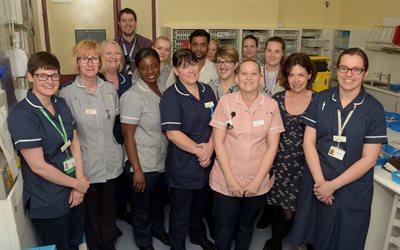Stem cell treatment closer to home

The Talbot Butler team
Patients receiving a highly specialist form of transplant therapy using their own stem cells can now be treated closer to home thanks to the re-introduction of the service at Northampton General Hospital.
Since April, our haematology department has been carrying out autologous stem cell transplants on Talbot Butler ward.
An autologous stem cell transplant involves collecting a patient’s stem cells and returning them at a later stage after extremely high doses of chemotherapy to eradicate their cancer. The infused stem cells help to speed up bone marrow recovery after high-dose chemotherapy.
Previously, patients received this specific treatment at the University Hospitals of Leicester. With the new service, patients travel to Leicester to have their stem cells collected but the transplant treatment is completed in Northampton.
"Clear advantages in terms of our patients' experience..."
Consultant haematologist Dr Jane Parker said: “A local transplant service offers treatment closer to home for patients and it’s delivered by the healthcare professionals they are familiar with, so there are clear advantages in terms of our patients’ experience.
“It benefits our haematology healthcare teams as well, by improving their knowledge and expertise in quite a specialist area. We’ve developed a training programme for our haematology nurses and doctors to ensure patients receive the best possible transplant care.
“It’s been made possible thanks to the hard work and collaboration between the transplant teams, managers and quality management teams at Northampton and University Hospitals of Leicester.”
The new transplant service has developed dedicated transplant clinics, transplant care plans, and specific transplant ward rounds. The service meets national and international standards of safe transplant care.
Factfile
- Patients first receive chemotherapy over a number of months to eliminate as much tumour as possible
- Their bone marrow stem cells are then stimulated with a combination of chemotherapy and growth factors to temporarily circulate in the blood.
- As soon as the stem cells reach peak numbers in the blood, patients travel to Leicester and undergo stem cell apheresis. This is a system whereby stem cells can be siphoned out of the blood and collected.
- The siphoned stem cells are carefully frozen and stored at Leicester for future use.
- Patients are then admitted onto the transplant unit.
- They first receive high dose chemotherapy to eliminate any residual tumour. Their stem cells are infused into the blood 24 hours later.
- The effects of the chemotherapy then start to kick in: patients develop severe mucositis, struggling to eat or swallow and developing severe diarrhoea. Their bone marrow is also completely eradicated, leaving them open to potentially life-threatening infections and requiring regular blood products. They are therefore nursed in single rooms with special air filters to reduce the risk of infection.
- The infused stem cells seed into the empty marrow and start to produce healthy blood cells around 2 weeks later.
- Patients can be discharged once their white cells recover and they can eat and drink sufficient amounts. Their hospital stay is usually around 4 weeks.
- It takes up to 3 months or more for full recovery. During this time, patients are closely monitored in specialist Haematology units. They receive their childhood vaccinations again at 6 months because their original immune system has been eradicated
Posted on Monday 11th September 2017